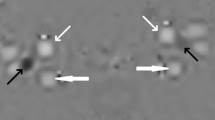Summary
Pial arterial and venous calibre changes during intracranial hypertension were studied in 11 cats under barbiturate- and nitrous oxide-anaesthesia by using a closed cranial window technique and multichannel videoangiometry. Intracranial pressure was elevated from a normal mean level of 6.4 mm Hg by cisternal infusion of mock CSF in steps to 20, 30, 40, 50 mm Hg and finally to the level of systolic pressure. Pial arteries dilated significantly, small ones more than large ones, by 42±5.6% and 33±3%, respectively at ICP 50. With a further elevation of ICP up to systolic pressure, dilatation diminished to 28±10% in small, and to near resting calibres in large arteries. Pial veins remained unreactive on the average. Grouping into veins smaller and larger than 100 μm of resting size revealed, however, minor though statistically significant 5–10% dilatation of small, and a 5–10% diminution of large veins. Blood flow stopped, when cerebral perfusion pressure was zero, however, neither arteries nor veins collapsed.
The present data support the hypothesis that CBF during acute elevation of CSF pressure depends on perfusion pressure rather than local vascular compression.
Similar content being viewed by others
References
Auer LM (1978) The pathogenesis of hypertensive encephalopathy. Acta Neurochir (Wien) [Suppl] 27: 1–111
Auer LM, Haydn F (1979) Multichannel videoangiometry for continuous measurement of pial microvessels. Acta Neurol Scand 60 [Suppl] 72: 208–209
Auer LM, Gallhofer B (1981) Rhythmic activity of cat pial vessels in vivo. Eur Neurol 20: 448–468
Auer LM, Sayama I (1983) Intracranial pressure oscillation (B-waves) caused by oscillation in cerebrovascular volume. Acta Neurochir (Wien) 68: 93–100
Auer LM, Loew F (eds) (1983) The cerebral veins. An experimental and clinical update. Springer, Wien New York
Auer LM, MacKenzie ET (1984) Physiology of the cerebral venous system. In: Kapp JP, Schmidek HM, (eds) The cerebral venous system and its disorders. Grune and Stratton, Inc., New York, pp 169–227
Auer LM, Haselsberger K (1985) Cerebrovascular effect of mannitol. In: Inaba Yet al, (eds) Brain edema. Springer, Berlin Heidelberg New York Tokyo, pp 668–671
Auer LM, Haselsberger K (1986) The effect of intravenous mannitol on cat pial arteries and veins during normal and elevated intracranial pressure. Submitted to Neurosurgery
Benabid AL, Persat JC, de Rougemont J,et al (1987) Intracranial pressure IV-relationship with post capillary vascular pressures. J Physiol 74: 369–378
Bruce DA, Langfitt TW, Miller JD,et al (1973) Regional cerebral blood flow, intracranial pressure, and brain metabolism in comatose patients. J Neurosurg 38: 131–144
Fieschi C, Battistini N, Beduschi A,et al (1974) Regional cerebral blood flow and intraventricular pressure in the acute head injuries. J Neurol Neurosurg Psychiatry 37: 1378–1388
Fog M (1933) Influence of intracranial hypertension upon the cerebral circulation. Acta Psychiatr Neurol Scand 8: 191–198
Folkow B, Neil E (1971) Circulation. Oxford University Press, New York London Toronto
Garcia de Sola R, Vaquero J, Cabezudo J, Bravo G (1980) Evolution of intracranial pressure and cerebral blood flow in cryogenic cerebral edema. In: Shulman K,et al (eds) Intracranial pressure IV. Springer, Berlin Heidelberg New York, pp 268–271
Grubb RL Jr, Raichle ME, Phelps ME, Ratcheson RA (1975) The effects of increased intracranial pressure upon cerebral blood volume, blood flow, and oxygen utilization. In: Harper M,et al (eds) Blood flow and metabolism in the brain. Churchill Livingstone, Edinburgh London New York, pp 6.12–6.16
Hedges TF, Weinstein JD (1964) Cerebrovascular responses to increased intracranial pressure. J Neurosurg 21: 292–297
Johnston IH, Rowan JO, Harper AM, Jenett WB (1972) Raised intracranial pressure and cerebral blood flow. 1. Cisterna magna infusion in primates. J Neurol Neurosurg Psychiatry 35: 285–296
Langfitt TW, Weinstein JD, Kassell NF (1965) Cerebral vasomotor paralysis produced by intracranial hypertension. Neurology 15: 622–641
Langfitt TW, Kassell NF, Weinstein JD (1965) Cerebral blood flow with intracranial hypertension. Neurology 15: 761–773
Langfitt TW, Weinstein JD, Kassell, NF,et al (1966) Compression of cerebral vessels by intracranial hypertension. I. Dural sinus pressures. Acta Neurochir (Wien) 15: 212–222
Luce JM, Huseby JS, Kirk W, Butler J (1982) A Starling resistor regulates cerebral venous outflow in dogs. J Appl Physiol 53: 1496–1503
Nakagawa Y, Tsuru M, Yada K (1974) Site and mechanim for compression of the venous system during experimental intracranial hypertension. J Neurosurg 41: 427–434
Portnoy HD, Chopp M, Branch C, Shannon M (1983) CSF and venous pulse waves; a look at myogenic autoregulation. In: Auer LM, Loew F (eds) The cerebral veins. An experimental and clinical update. Springer, Wien New York, pp 213–221
Sano H, Kawase T, Toya S (1983) The changes in the cerebral microcirculation during increased intracranial pressure. In: Auer LM, Loew F (eds) The cerebral veins. An experimental and clinical update. Springer, Wien New York, pp 231–238
Shulman K (1965) Small artery and vein pressures in the subarachnoid space of the dog. J Surg Res 5: 56–61
Shulman K, Verdier GR (1967) Cerebral vascular resistance changes in response to cerebrospinal fluid pressure. Am J Physiol 213: 1084–1088
Wagner EM, Traystman RJ (1983) Effects of cerebral venous and cerebrospinal fluid pressure on cerebral blood flow. In: Auer LM, Loew F (eds) The cerebral veins. An experimental and clinical update. Springer, Wien New York, pp 223–230
Wei EP, Kontos HA (1981) Responses of pial arterioles to increased venous pressure. J Cereb Blood Flow Metab 1 [Suppl] 1: 329–330
Wolff HG, Forbes HS (1928) The cerebral circulation. V. Observations of the pial circulation during changes in intracranial pressure. Arch Neurol Psychiat 20: 1035–1047
Wright DR, (1938) Experimental observations on increased intracranial pressure. Australian New Zealand J Surg 7: 215–235
Yada K, Nakagawa Y, Tsuru M (1973) Circulatory disturbance of the venous system during experimental intracranial hypertension. J Neurosurg 39: 723–729
Author information
Authors and Affiliations
Rights and permissions
About this article
Cite this article
Auer, L.M., Ishivama, N. & Pucher, R. Cerebrovascular response to intracranial hypertension. Acta neurochir 84, 124–128 (1987). https://doi.org/10.1007/BF01418837
Issue Date:
DOI: https://doi.org/10.1007/BF01418837




